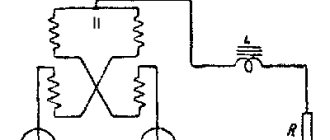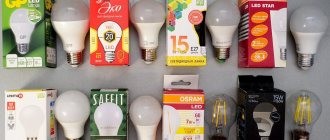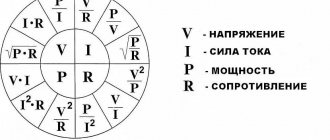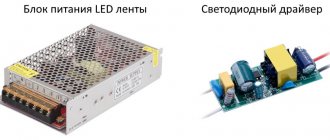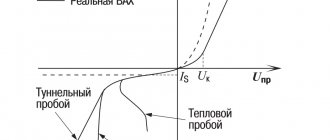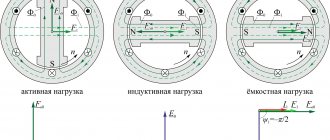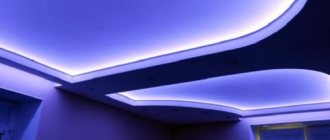Today we propose to talk about determining the power of an LED lamp. Power is the rate at which electrical energy is converted. The value is measured in watts, indicating the work done in 1 second. It turns out that the power consumption of an LED lamp affects its brightness. However, not all so simple. Manufacturers of modern devices are trying to increase the luminous efficiency of each consumed watt, and successfully. For example, the light level of an 8-watt source released this year is identical to a 10-watt device manufactured a year ago. Manufacturers are not going to stop there. The development of energy efficiency of LED lamps, including high-power devices, will continue.
When choosing a suitable product instead of a fluorescent device or incandescent lamp, take into account all the basic characteristics of the product. After all, two seemingly identical light sources may have different color rendering coefficients, luminous flux, types and parameters of caps, and color temperature. Accordingly, the level of illumination will be perceived differently. In addition, the dispersion angle also differs. So, let’s figure out how to determine the power of an LED, and also try to choose the right product.
Level of natural light
This parameter cannot be called the main one, and it would probably be a mistake when calculating a “bright” room (located on the sunny side) to reduce the requirements for artificial lighting. After all, we use it not only during the day, but also late in the evening, and in winter, when the sun sets much earlier.
But there are rooms that we usually call “dark”, for example, a bathroom with no window openings at all or a bedroom with small windows facing north. It is better to consider their lighting at the upper limit of the recommended characteristics.
By the way, during serious “industrial” design of interior lighting of buildings, engineers also take into account the reflective characteristics of the facades of neighboring buildings and the features of their location.
Transparency of lampshade/diffuser
Obviously, if we enclose the lamp inside a white matte ball, then we will definitely lose some of the light. The situation is a little better with lampshades, which represent a “bell” or “lampshade”. It’s not bad when the lamp is completely open or installed inside a transparent shade.
Note that over time, chandelier shades and diffusers of LED lamps/strips may lose (for various reasons: pollution, natural clouding) their light transmission capabilities, which also needs to be taken into account and periodically monitored.
Some general considerations on the resistance of incandescent light bulbs
Of course, for small voltage values (when the applied voltage differs SIGNIFICANTLY from the nameplate voltage), our formulas will be “twisted”.
For example, when calculating the resistance of a 95W, 230V indoor incandescent light bulb connected to a voltage source of 1 volt, the formula is:
gives a filament resistance value of 36.7171 ohms.
If we assume that we apply a voltage of 0.1 volts to the lamp, then the calculated filament resistance will be 11.611 ohms.
Intuition suggests that this is not entirely the case, but rather that it is not the case at all.
In the region of low voltages, the formula will consistently “lower” the value of the calculated resistance compared to the actual one, and this is the point.
In the concept under consideration, it is implicitly assumed that the chaotic movement of electrons will “freeze” in the absence of an external applied voltage. However, it is obvious that the movement of electrons does not “freeze” even in the absence of an applied external voltage (if the lamp is simply lying on the table and is not turned on anywhere).
The chaotic movement of electrons is of a thermal nature and is caused by the natural temperature of the filament.
This point is not taken into account by the formula, and direct measurement of the thread resistance with a device will inevitably show the difference between the measured resistance value and the calculated one.
Calculation of the optimal power of LED lamps
It is recommended to calculate the optimal lighting power when repairing and installing lamps. So, you will always know what power you need to purchase lamps and how long they will last. In the event that you need to know how much power LEDs should have in one room, you need to know certain parameters:
- Light level;
- Area of one room;
- Number of lamps to be installed;
- Light flow;
- Room illumination level.
To calculate the luminous flux that comes from one lamp, you must use the following formula:
If you need to find out the level of illumination per square meter, then use the formula:
A little “algebraic scholasticism”
Now that the “theory” is over (smiled), I will give algebraic calculations to derive the “main” formula.
The canonical notation of Ohm's law looks like this:
To harmonize the quantitative values, it is necessary to enter the appropriate proportionality coefficients, for the current component - Kt and for the resistive component - Kr:
The most general considerations lead to the idea that these coefficients should be mutually inverse quantities, which means:
In this case, multiplying the right and left sides in pairs (in the system of equations), we return to the original notation of Ohm’s law:
Errors in calculations
During renovation work, the plans of the owners of the premises often include replacing conventional incandescent lamps with LED lamps, after which the illumination level may decrease several times.
The reason for this can be a huge number of factors, which include:
- Use of wallpaper, laminate, linoleum in dark shades;
- Incorrect determination of LED color temperature;
- Installation of a stretch ceiling with a matte effect.
Therefore, when determining illumination, it is necessary to take into account the coefficients of the main surfaces of the room - the ceiling, walls and floor:
- 70% – white;
- 50% – light color;
- 30% – gray color;
- 10% – dark color;
- 0% – black color.
To do this, calculate the overall reflectance:
· General K.O.= K.O. ceiling+K.O.walls+K.O.floor)/3.
Once the result has been obtained, it must be multiplied by the previously calculated luminous flux.
Radiation power relative to the surrounding background
Let us estimate the lamp radiation power corresponding to the ambient background temperature.
It is known that the Stefan-Boltzmann constant σ = 5.670373·10 -8, then the radiation power per square meter
As an arbitrary estimate value, we will take the diameter of the spiral to be 40 microns and the length to be 50 cm. The normal temperature is 293K (20C). Substituting these data into the Stefan-Boltzmann formula, we obtain the radiation power at a temperature of 0.026258 Watt.
For fun, let's calculate the power at some different ambient temperatures:
| Minus 40 (233 K) | 0.0105 Watt |
| Minus 20 (253 K) | 0.0146 Watt |
| Zero (273 K) | 0.0198 Watt |
| Plus 20 (293 K) | 0.026258 Watt (standard conditions) |
| Plus 40 (313 K) | 0.0342 Watt |
For fun, you can give a calculation of the lamp radiation when the ambient temperature is 2300K:
P = 99.7 Watt.
Which generally agrees well with the real state of affairs - a lamp rated at 100 watts heats up to a temperature of 2300K.
We can say with a high degree of confidence that this spiral geometry corresponds to a “100-watt” light bulb rated at 220 volts.
Now let’s recalculate these power values to the “reduced” voltage. As if the ambient temperature corresponded to Absolute Zero, and some voltage was applied to the lamp, heating the coil.
To recalculate, we use the resulting relationship that voltage and power correspond to powers of “three” and “two”.
| Temp., K | Voltage, V |
| 233 | 0,489665457 |
| 253 | 0,609918399 |
| 273 | 0,747109176 |
| 293 | 0,902119352 |
| 313 | 1,075809178 |
The table shows that the “current” power of the light bulb when the voltage across it is 0.902. Volt heats the coil to a temperature of 293K. Likewise, “current” power at a voltage of 1.0758 Volts will heat the coil to a temperature of 313K (20 degrees higher).
I repeat once again, this is provided that the ambient temperature is equal to Absolute Zero.
Conclusion. A very small change in voltage has a significant effect on the temperature of the filament. They changed the voltage by some seventeen hundredths of a Volt (1.0758 - 0.902 = 0.1738) and the temperature increased by 20 degrees.
These calculations are very arbitrary, but they can be used as estimates .
The estimate is naturally very rough, because the Stefan-Boltzmann law describes the radiation of an “ideal” emitter - an absolutely black body (BLB), and the spiral is very different from the BLB, but, nevertheless, we obtained a very plausible “number”.
From the Excel plate it can be seen that even at a lamp voltage of 1 volt, the temperature of the coil will be 40 degrees Celsius. Let's do more, there will be more.
The natural conclusion is that at a voltage of 10-15 volts the thread will be quite hot, although this will not be visible visually.
To the eye, the thread will appear “black” (cold) up to temperatures of 600 degrees (the beginning of radiation in the visible range).
Those who want to “drive the numbers” can do this on their own using the Stefan-Boltzmann formula.
The results will be conditional, due to the fact that (as mentioned above) the spiral has some albedo and does not correspond to the black body emitter, BUT(!) the temperature estimate will be quite reliable.
I repeat - it’s just an assessment . The filament begins to glow at about 20 volts.
Additionally, I would like to draw attention to the variation in the parameters of the light bulbs.
In the photo with the tester, the small light bulbs (garland) were selected and calibrated by me very carefully. For various measurement purposes and experiments. That’s why they show the same resistance, which is called “bullet to bullet.”
But the large light bulbs, I just brought them from the store, without selecting them according to parameters, and it is clearly visible that the spread of store-bought light bulbs is observed in a very wide range. Up to 10%.
This circumstance additionally indicates that the calculation errors are less than the actual spread of light bulbs.
Colorful temperature
This parameter describes the degree of naturalness of the light emitted by the lamp. Color temperature is measured in Kelvin.
All shades of artificial lighting, depending on their belonging to one or another part of the spectrum, are conventionally divided into three groups:
- Warm shades fall in the range of 2700-4000K;
- Neutral 4000-5000 K;
- Cold 5000K and above.
The color of light is clearly visible to the human eye and can have different effects on the psyche and performance. Warm and neutral shades soothe, relax, and create an atmosphere for comfortable relaxation. Cold ones stimulate the nervous system, help increase concentration, but increase fatigue and can become serious irritants.
Traditional incandescent and halogen lamps are capable of emitting only the warm part of the spectrum. LED and fluorescent light sources, depending on the composition of the phosphor that is responsible for the radiation, can glow with warm, neutral, and cold light. The information on its packaging will help you find out the color temperature of a particular light bulb.
How to calculate the power of a lamp?
When planning to buy lamps in Minsk, you will be faced with the need to determine the proper level of illumination. Read the data below, which approximately indicates the required power of the light source to effectively illuminate 1m2 of room.
For incandescent lamps:
- bedroom - 10-12 W/m2;
- kitchen, children's room, office, bathroom - 15-18 W/m2;
- living room - 20 W/m2.
Comparison with other lamps: LED 1 W = incandescent 7.5 W, compact fluorescent 1 W = 5.5 W incandescent. By converting the data taking into account new values, types of light bulbs and area of the room, the required power of the lighting device is obtained.
How to choose the right lighting in a room
Currently, there are standards for room illumination that guide large organizations (industrial premises, offices, hotels, restaurants). To calculate LED lighting in an apartment, you can use these parameters:
- Office – 250 lux;
- Meeting room - 434 suites;
- Garage - 108 suites;
- Reading room - 431 suites;
- Kitchen - 108 suites.
Well, below is a table of the power of different types of lamps for rooms for different purposes.
It is worth noting that room illumination is measured in lux using a special device. However, in residential rooms, the average illumination level is 54 lux.
Luminous flux unit
Lumens are used to measure luminous flux; the value for a specific light bulb is printed on the original packaging.
1 lumen is a beam of light produced by a source of 1 candela power within an angle of 1 steradian (sr). If we use numbers, it turns out that 1 lm emits a source with a power of 1/683 W at a wavelength of 555 Nm.
A steradian is an angle that cuts out an area with a certain radius (p) in a sphere. This means that 1 cd emits 4p lm.
There are derived units of measurement for lighting engineering:
- microlumen – 10-6 lm;
- millilumen – 10-3 lm;
- kilolumens – 103 lm;
- megalumen - 106 lm, etc.
Principle of operation
The source works by emitting wave radiation due to electronic molecular excitation and atoms, as well as due to thermal vibration of the filament molecular nucleus. As the temperature of the filament increases, the translational, vibrational and rotational energy of charged particles increases. As a result, the flux of radiation with average photon energy increases. The radiative wavelength moves into the short-wave infrared and long-wave visible regions. In the future, the body temperature will increase, providing energy that is sufficient to excite molecules and atoms and produce short-wave visible radiation. Therefore, the main factor that determines density with radiation wavelength is temperature.
You might be interested in Features of a fluorescent lamp
Operating principle of incandescent lamps
Device
The incandescent lamp includes a glass bulb, a tungsten filament, a lead wire, a molybdenum filament holder, a loge, a bimetallic wire, a bushing, a fuse link, putty, a plug, a light weight lead wire, a base and a solder contact. A light source with a glass bulb, a tungsten filament and an inert gas is installed on special supports and electrodes through which electric current flows.
Note! At the moment the base is screwed into the source, the energy goes to the heated tungsten and emits light. This is considered to be the operating principle.
Design features of lamps
Specifications
The main technical characteristics of a 60 W incandescent lamp are electrical with lighting and operational parameters. The first includes power with voltage, the second - light flux with spectral composition, the third - light output with service life and geometric size. The power of the light sources depends on the voltage and geometric dimensions of the tungsten filament.
As for the power range, it ranges from 25 to 1000 watts. The tungsten filament is 3000 degrees, the light output is 9-19 lumens per 1 watt, the rated voltage is 220-230 watts. The frequency is 50 hertz, the base size is from 14 to 40 millimeters. The base itself is threaded, pin and two-pin.
Technical parameters of lamps with a power of 220 volts
about the author
Stanislav Albertovich Matrosov lives in St. Petersburg. Electrical engineer by training. Graduated from LETI im. V.I. Ulyanov (Lenin) in 1977, majoring in “Optical and physical devices”.
Not without reason, the article can be considered a small, but completely new word in matters of engineering and practical application of such “ordinary, but unusual” devices as an incandescent light bulb.
Two light bulbs from a New Year's garland are switched on in series
How to choose the lamp power?
To calculate power, perform the necessary calculations:
- find the area of the room using the formula: S=AxB;
- take the desired value for the norm of illumination of objects (E). Living room - 200 Lux, kitchen - 150 Lux, children's room - 200 Lux, bathroom - 50 Lux.
- determine the required luminous flux using the formula: Fl = ExSxZ, where Z is the correction factor for the height of the ceiling surface. At a height of 2.5-2.7 m, coefficient Z=1, at a height of 2.7-3m - Z=1.2;
- use data indicating the power of the lamps and the luminous flux they emit. For example, a 20W incandescent lamp produces about 250 Lm, 40W - 400 Lm, 60W - 700 Lm, 75 W - 900 Lm, 100 W - 1200 Lm (1 Lm = 1 Lm/m2). Determine the required number of light sources. Sum up their load and get the required value for your lamp.
